FLIR Systems FLIRT5590 Infrared Camera User Manual Part 3
FLIR Systems AB Infrared Camera Part 3
Contents
- 1. User Manual Part 1
- 2. User Manual Part 2
- 3. User Manual Part 4
- 4. User Manual Part 3
User Manual Part 3
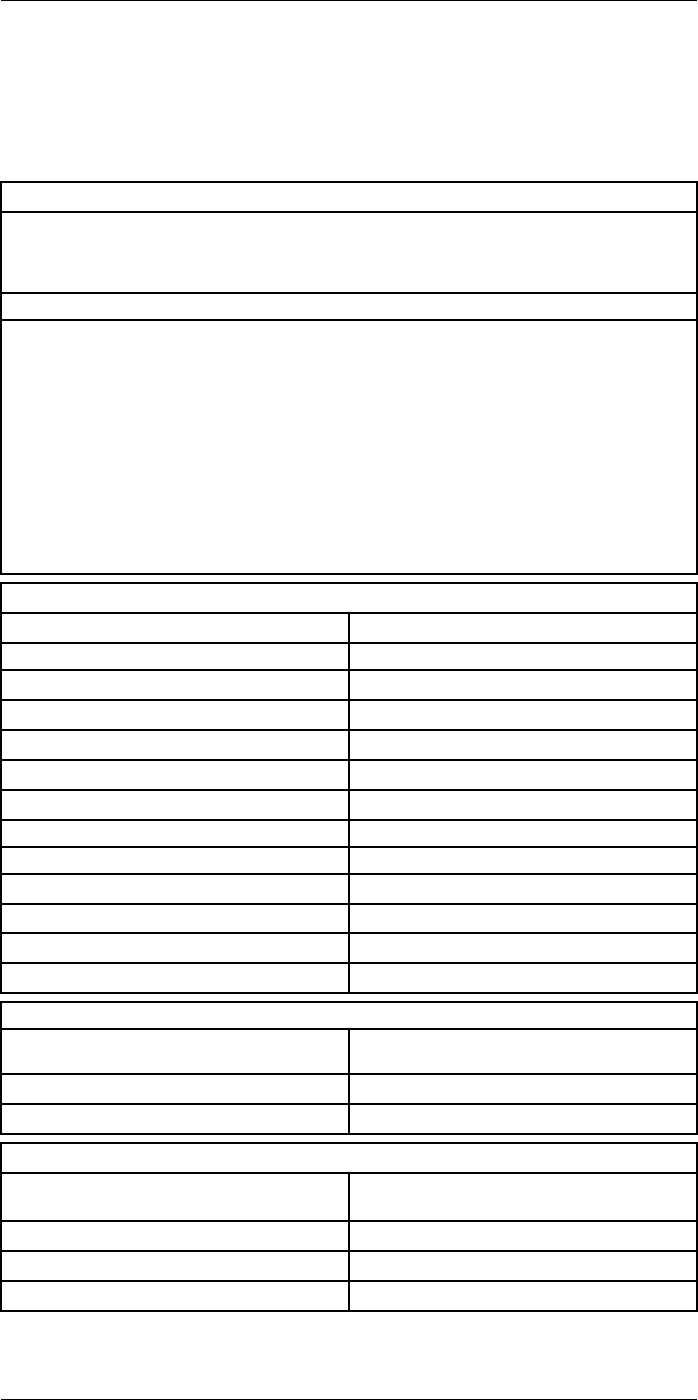
Technical data24
24.66 FLIR T660 45° (incl. Wi-Fi)
P/N: 55904-8622
Rev.: 43545
General description
The FLIR T660 is designed for the expert requiring the highest performance and the latest technology
available. The camera combines excellent ergonomics and a walk-up-and-use interface with superior
image quality of 640 × 480 pixel infrared resolution. The FLIR T660 is flexible and can meet your every
need.
Benefits:
• Highest performance with the latest technology: The FLIR T660 is equipped with the innovative Multi
Spectral Dynamic Imaging (MSX) feature, which produces an image richer in detail than ever before.
Continuous auto-focus makes the FLIR T660 the first fully automatic infrared camera on the market.
• Ground-breaking efficiency: You can highlight objects of interest, on both the infrared and the visual
images, by sketching or adding predefined stamps directly onto the camera’s capacitive touch
screen. The user interface is intuitive and logical for effective operation. Auto-orientation allows you
to tilt between landscape and portrait views.
• Extensive communication options: The Wi-Fi connectivity of the FLIR T660 allows you to connect to
smart phones or tablets for the wireless transfer of images or the remote control of the camera. The
Bluetooth-based METERLiNK function transfers readings from external measurement instruments
to the infrared image.
• Support for UltraMax: When enabling UltraMax in the camera, the resolution of images can be sub-
stantially enhanced when importing the images into FLIR Tools.
Imaging and optical data
IR resolution 640 × 480 pixels
UltraMax Yes
Thermal sensitivity/NETD <20 mK @ +30°C (+86°F)
Field of view (FOV) 45° × 34°
Minimum focus distance 0.15 m (0.49 ft.)
Focal length 13 mm (0.52 in.)
Spatial resolution (IFOV) 1.30 mrad
Lens identification Automatic
F-number 1.0
Image frequency 30 Hz
Focus Continuous, one shot or manual
Digital zoom 1–8× continuous
Digital image enhancement Adaptive digital noise reduction
Detector data
Detector type Focal plane array (FPA), uncooled
microbolometer
Spectral range 7.5–14 µm
Detector pitch 17 µm
Image presentation
Display Built-in touch screen, 4.3 in. wide screen LCD,
800 × 480 pixels
Display type Capacitive touch screen
Auto orientation Automatic landscape or portrait
Viewfinder Built-in 800 × 480 pixels
#T559880; r. AL/45866/46124; en-US 438

Technical data24
Image presentation
Automatic image adjustment Continuous, histogram based
Manual image adjustment Linear based; possible to adjust level/span/max./
min.
Image presentation modes
Infrared image Full-color IR image
Visual image Full color visual image
Thermal MSX Thermal image with enhanced detail presentation
Picture in Picture Resizable and movable IR area on visual image
Measurement
Object temperature range • –40°C to +150°C (–40°F to +302°F)
• +100°C to +650°C (+212°F to +1202°F)
• +300°C to +2000°C (+572°F to +3632°F)
Accuracy • ±1°C (±1.8°F) or ±1% of reading for limited
temperature range.
• ±2°C (±3.6°F) or 2%, whichever is greater, at
25°C (77°F) nominal.
Measurement analysis
Spotmeter 10
Area 5 + 5 areas (boxes or circles) with max./min./aver-
age (in post-acquisition analysis)
Profile 1 line profile with max/min temp
Automatic hot/cold detection Auto hot or cold spotmeter markers within area
and profile
Measurement presets No measurements, Center spot, Hot spot, Cold
spot, User preset 1, User preset 2
User presets (in live images) The user can select and combine measurements
from any number of available spots/boxes/circles/
profiles/delta
Difference temperature Delta temperature between measurement func-
tions or reference temperature
Reference temperature Manually set using difference temperature
Atmospheric transmission correction Automatic, based on inputs for distance, atmos-
pheric temperature and relative humidity
Optics transmission correction Automatic, based on signals from internal sensors
Emissivity correction Variable from 0.01 to 1.0 or selected from materi-
als list
Emissivity table Emissivity table of predefined materials
Reflected apparent temperature correction Automatic, based on input of reflected
temperature
External optics/windows correction Automatic, based on inputs of window transmis-
sion and temperature
Measurement corrections Emissivity, reflected temperature, relative humidity,
atmospheric temperature, object distance, exter-
nal IR window compensation
Colors (palettes) Iron, Rainbow, Rainbow HC, White hot, Black hot,
Arctic, Lava
#T559880; r. AL/45866/46124; en-US 439

Technical data24
Alarm
Color Alarm (isotherm) Above/below/interval
Measurement function alarm Audible/visual alarms (above/below) on any se-
lected measurement function
Screening Difference temperature alarm, audible
Set-up
Set-up commands Define user presets, Save options, Programmable
button, Reset options, Set up camera, Wi-Fi, GPS
& compass, Bluetooth, Language, Time & units,
Camera information
Service functions
Camera software update Use PC software FLIR Tools
Storage of images
Image storage Standard JPEG, including digital photo and meas-
urement data, on memory card
Storage media Removable memory SD card
Image storage mode • Simultaneous storage of thermal and digital
photo in same JPEG file.
• Optional to store digital photo as a separate
JPEG file.
Time lapse 15 seconds to 24 hours
File formats Standard JPEG, measurement data included
File formats, visual Standard JPEG, automatically associated with
corresponding thermal image
Image annotations (in still images)
Voice 60 seconds (via Bluetooth) stored with the image
Text Add table. Select between predefined templates
or create your own in FLIR Tools
Image description Add short note (stored in JPEG EXIF tag)
Sketch Draw on thermal/digital photo or add predefined
stamps
METERLiNK Wireless connection (Bluetooth) to:
FLIR meters with METERLiNK
Report generation • Instant Report (*.pdf file) in camera
• Separate PC software with extensive report
generation
Geographic Information System
GPS Location data automatically added to every still
image from built-in GPS
Compass Camera direction automatically added to every
still image
Video recording in camera
Radiometric IR video recording CSQ to memory card
Non-radiometric IR video recording MPEG-4 to memory card
Visual video recording MPEG-4 to memory card
#T559880; r. AL/45866/46124; en-US 440
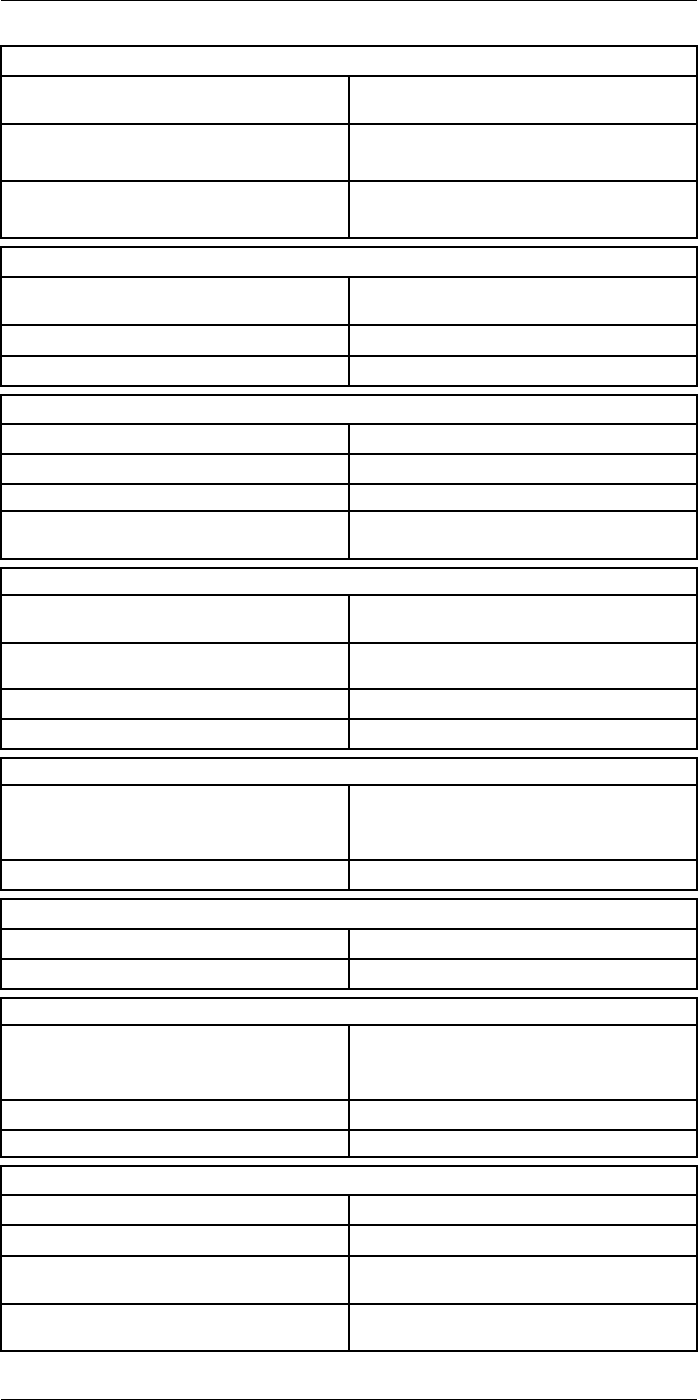
Technical data24
Video streaming
Radiometric IR video streaming Full dynamic to PC using USB or to mobile devi-
ces using Wi-Fi.
Non-radiometric IR video streaming • MPEG-4 using Wi-Fi
• Uncompressed colorized video using USB
Visual video streaming • MPEG-4 using Wi-Fi
• Uncompressed colorized video using USB
Digital camera
Built-in digital camera 5 Mpixels with LED light (photo as separate
image)
Digital camera, FOV Adapts to the IR lens
Video lamp Built-in LED light
Laser pointer
Laser Activated by dedicated button
Laser alignment Position is automatic displayed on the IR image
Laser classification Class 2
Laser type Semiconductor AlGaInP diode laser, 1 mW, 635
nm (red)
Data communication interfaces
Interfaces USB-mini, USB-A, Bluetooth, Wi-Fi, Digital Video
Output
METERLiNK/Bluetooth Communication with headset and external
sensors
Wi-Fi Peer to peer (ad hoc) or infrastructure (network)
SD Card One card slot for removable SD memory cards
USB
USB • USB-A: Connect external USB device
• USB Mini-B: Data transfer to and from PC / un-
compressed colorized video
USB, standard USB 2.0 high speed
Video output
Video out Digital video output (DVI)
Video, connector type HDMI compatible
Radio
Wi-Fi • Standard: 802.11 b/g
• Frequency range: 2412–2462 MHz
• Max. output power: 15 dBm
METERLiNK/Bluetooth Frequency range: 2402–2480 MHz
Antenna Internal
Power system
Battery type Rechargeable Li ion battery
Battery operating time > 2.5 hours at 25°C (+68°F) and typical use
Charging system In camera (AC adapter or 12 V from a vehicle) or
2-bay charger
Charging time 2.5 h to 90 % capacity, charging status indicated
by LED's
#T559880; r. AL/45866/46124; en-US 441
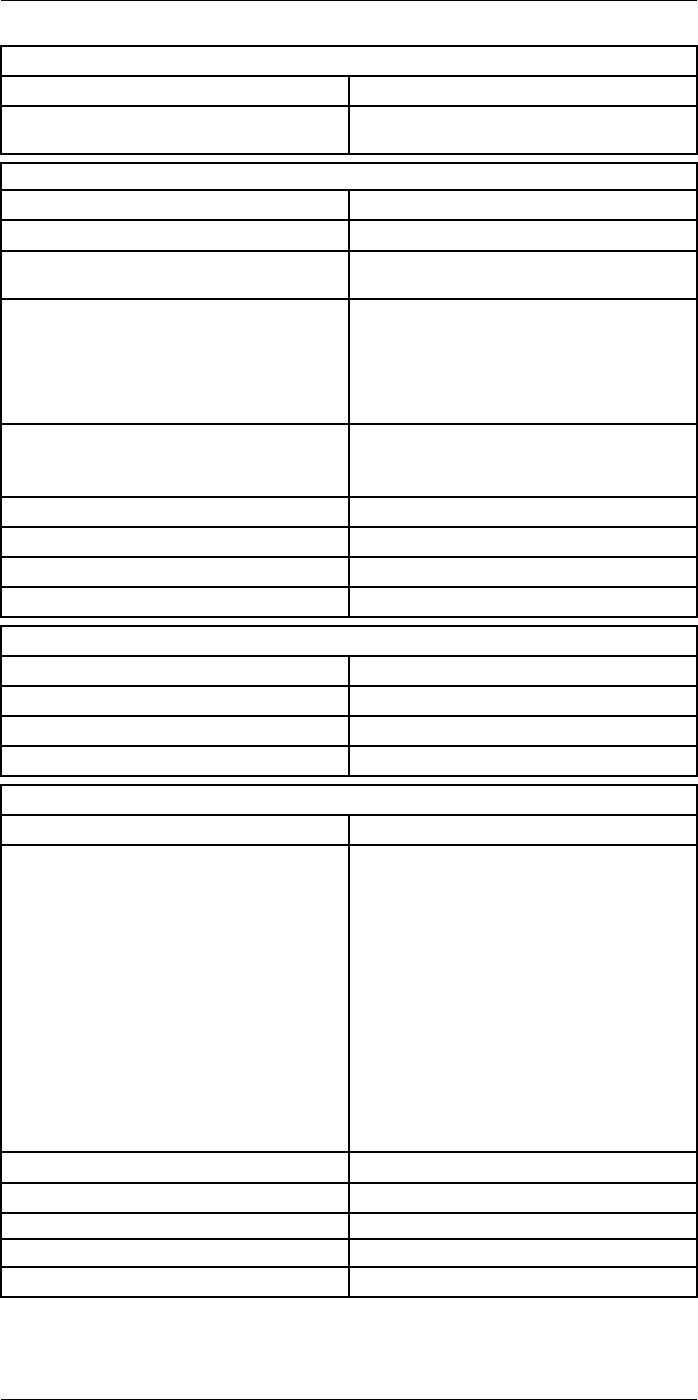
Technical data24
Power system
Charging temperature 0°C to +45°C (+32°F to +113°F)
External power operation AC adapter 90–260 VAC, 50/60 Hz or 12 V from a
vehicle (cable with standard plug, optional)
Environmental data
Operating temperature range –15°C to +50°C (+5°F to +122°F)
Storage temperature range –40°C to +70°C (–40°F to +158°F)
Humidity (operating and storage) IEC 60068-2-30/24 h 95% relative humidity +25°C
to +40°C (+77°F to +104°F) / 2 cycles
EMC • ETSI EN 301 489-1 (radio)
• ETSI EN 301 489-17
• EN 61000-6-2 (Immunity)
• EN 61000-6-3 (Emission)
• FCC 47 CFR Part 15 Class B (Emission)
• ICES-003
Radio spectrum • ETSI EN 300 328
• FCC Part 15.247
• RSS-247 Issue 2
Encapsulation IP 54 (IEC 60529)
Shock 25 g (IEC 60068-2-27)
Vibration 2 g (IEC 60068-2-6)
Safety EN/UL/CSA/PSE 60950-1
Physical data
Weight 1.3 kg (2.87 lb.)
Camera size, excl. lens (L × W × H) 143 × 195 × 95 mm (5.6 × 7.7 × 3.7 in.)
Tripod mounting UNC ¼"-20
Housing material Magnesium
Shipping information
Packaging, type Cardboard box
List of contents • Infrared camera with lens
• Battery (2 ea.)
• Battery charger
• Bluetooth headset
• Calibration certificate
• Printed documentation
• HDMI-DVI cable
• HDMI-HDMI cable
• Hard transport case
• Large eyecap
• Lens cap
• Memory card
• Neck strap
• Power supply, incl. multi-plugs
• Tripod adapter
• USB cable, Std A to Mini-B
Packaging, weight 6.6 kg (14.6 lb.)
Packaging, size 495 × 192 × 370 mm (19.49 × 7.56 × 14.57 in.)
EAN-13 7332558008768
UPC-12 845188009281
Country of origin Sweden
Supplies & accessories:
• T197914; IR lens, f=41.3 mm (15°) with case
#T559880; r. AL/45866/46124; en-US 442

Technical data24
• T197922; IR lens, f=24.6 mm (25°) with case
• T197915; IR lens, f=13.1 mm (45°) with case
• T198059; Close-up IR lens, 2.9× (50 µm) with case
• T198060; Close-up IR lens, 5.8× (100 µm) with case
• T198166; IR lens, f=88.9 mm (7°) with case and support for T6xx
• T198065; IR lens, f=6.5 mm (80°) with case
• T198066; Close-up IR lens, 1.5× (25 µm) with case
• T197896; High temperature option +300°C to 2000°C (+572°F to 3632°F)
• T910814; Power supply, incl. multi plugs
• T198126; Battery charger, incl. power supply with multi plugs T6xx
• T199406ACC; Battery Li-ion 3.7 V, 7.8 Ah, 29 Wh
• T911650ACC; Memory card SD Card 8 GB
• 1910423; USB cable Std A <-> Mini-B
• T198509; Cigarette lighter adapter kit, 12 VDC, 1.2 m/3.9 ft.
• T910930ACC; HDMI type C to DVI cable 1.5 m
• T910891ACC; HDMI type C to HDMI type A cable 1.5 m
• T198625ACC; Hard transport case
• T198495; Pouch
• T198497; Large eyecup
• T198498; Tripod Adapter
• T198499; Neck strap
• T197771ACC; Bluetooth Headset
• T911093; Tool belt
• 19250-100; IR Window 2 in
• 19251-100; IR Window 3 in.
• 19252-100; IR Window 4 in.
• 19250-200; SS IR Window 2 in.
• 19251-200; SS IR Window 3 in.
• 19252-200; SS IR Window 4 in.
• T198496; Stylus pen
• T198586; FLIR Reporter Professional (license only)
• T198584; FLIR Tools
• T198583; FLIR Tools+ (download card incl. license key)
• DSW-10000; FLIR IR Camera Player
• APP-10002; FLIR Tools Mobile (Android Application)
• APP-10004; FLIR Tools (MacOS Application)
• T199233; FLIR Atlas SDK for .NET
• T199234; FLIR Atlas SDK for MATLAB
#T559880; r. AL/45866/46124; en-US 443
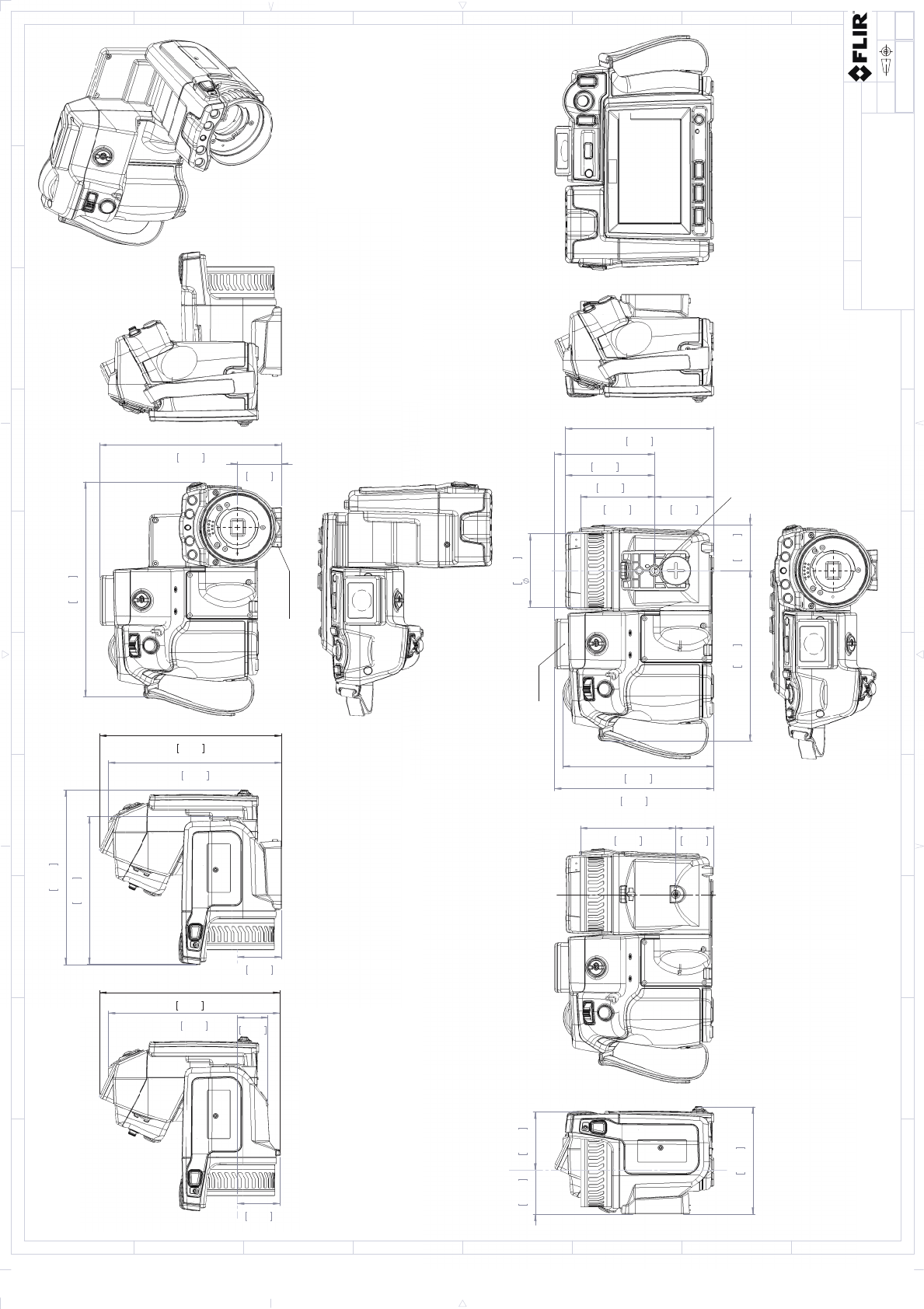
LQ
PP
LQ
PP
LQ
PP
7ULSRG6SDFHU
2SWLRQDO
LQ
PP
LQ
PP
LQ
PP
LQ
PP
LQ
PP
LQ
PP
LQ
PP
LQ
PP
LQ
PP
LQ
PP
LQ
PP
LQ
PP
LQ
PP
LQ
PP
LQ
PP
2SWLFDOD[LV
81&
9LHZILQGHU
2SWLRQDO
LQ
PP
LQ
PP
LQ
PP
2SWLFDOD[LV
LQ
PP
LQ
PP
2SWLFDOD[LV
LQ
PP
LQ
PP
LQ
PP
LQ
PP
&DPHUDKRXVLQJ
$
%
&
'
(
)
*
+
)
&
(
*
'
$
%
6FDOH
$
6L]H
0RGLILHG
5'7KHUPRJUDSK\
-27$
%DVLFGLPHQVLRQV)/,57[[PNOO
7
$
'HQRPLQDWLRQ
'UDZQE\
&KHFN
6L]H
'UDZLQJ1R
6KHHW
)/,56\VWHPV,QF$OOULJKWVUHVHUYHGZRUOGZLGH1RSDUWRIWKLVGUDZLQJPD\EHUHSURGXFHGVWRUHGLQDUHWULHYDOV\VWHPRUWUDQVPLWWHGLQDQ\IRUPRUE\DQ\PHDQVHOHFWURQLFPHFKDQLFDOSKRWRFRS\LQJUHFRUGLQJRURWKHUZLVH
ZLWKRXWZULWWHQSHUPLVVLRQIURP)/,56\VWHPV,QF6SHFLILFDWLRQVVXEMHFWWRFKDQJHZLWKRXWIXUWKHUQRWLFH'LPHQVLRQDOGDWDLVEDVHGRQQRPLQDOYDOXHV3URGXFWVPD\EHVXEMHFWWRUHJLRQDOPDUNHWFRQVLGHUDWLRQV/LFHQVHSURFHGXUHVPD\DSSO\
3URGXFWPD\EHVXEMHFWWR86([SRUW5HJXODWLRQV3OHDVHUHIHUWRH[SRUWTXHVWLRQV#IOLUFRPZLWKDQ\TXHVWLRQV'LYHUVLRQFRQWUDU\WR86ODZLVSURKLELWHG
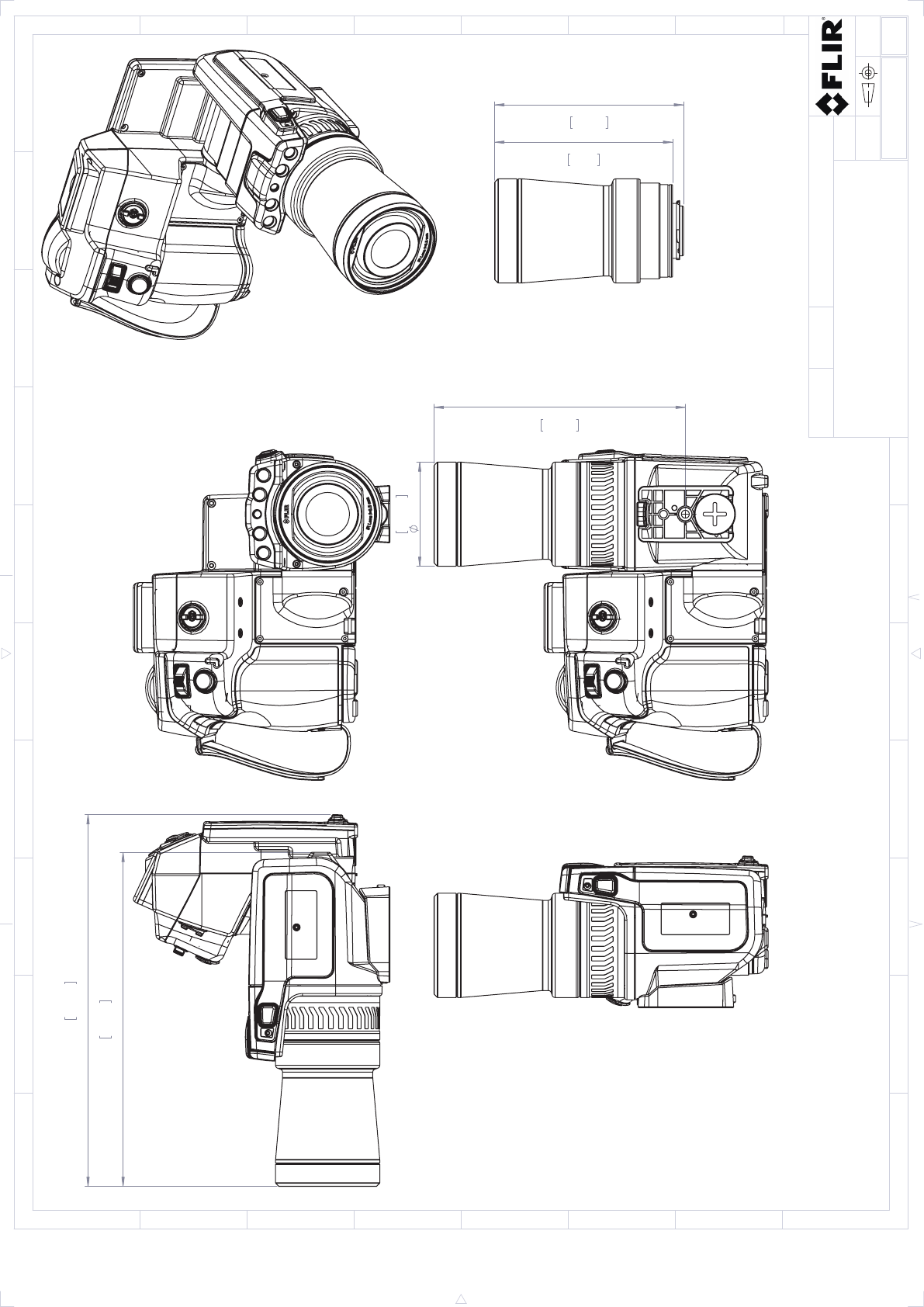
LQ
PP
LQ
PP
LQ
PP
LQ
PP
LQ
PP
LQ
PP
)RUDGGLWLRQDOGLPHQVLRQVVHHSDJH
&DPHUDZLWK/HQV,5I PP
6KHHW
'UDZLQJ1R
6L]H
&KHFN
'UDZQE\
'HQRPLQDWLRQ
$
7
%DVLFGLPHQVLRQV)/,57[[PNOO
-27$
5'7KHUPRJUDSK\
0RGLILHG
$
%
&
'
(
)
*
+
&
)
%
'
*
(
$
6L]H
$
6FDOH
)/,56\VWHPV,QF$OOULJKWVUHVHUYHGZRUOGZLGH1RSDUWRIWKLVGUDZLQJPD\EHUHSURGXFHGVWRUHGLQDUHWULHYDOV\VWHPRUWUDQVPLWWHGLQDQ\IRUPRUE\DQ\PHDQVHOHFWURQLFPHFKDQLFDOSKRWRFRS\LQJUHFRUGLQJRURWKHUZLVH
ZLWKRXWZULWWHQSHUPLVVLRQIURP)/,56\VWHPV,QF6SHFLILFDWLRQVVXEMHFWWRFKDQJHZLWKRXWIXUWKHUQRWLFH'LPHQVLRQDOGDWDLVEDVHGRQQRPLQDOYDOXHV3URGXFWVPD\EHVXEMHFWWRUHJLRQDOPDUNHWFRQVLGHUDWLRQV/LFHQVHSURFHGXUHVPD\DSSO\
3URGXFWPD\EHVXEMHFWWR86([SRUW5HJXODWLRQV3OHDVHUHIHUWRH[SRUWTXHVWLRQV#IOLUFRPZLWKDQ\TXHVWLRQV'LYHUVLRQFRQWUDU\WR86ODZLVSURKLELWHG

LQ
PP
LQ
PP
LQ
PP
LQ
PP
LQ
PP
LQ
PP
LQ
PP
)RUDGGLWLRQDOGLPHQVLRQVVHHSDJH
&DPHUDZLWK/HQV,5I PP
6KHHW
'UDZLQJ1R
6L]H
&KHFN
'UDZQE\
'HQRPLQDWLRQ
$
7
%DVLFGLPHQVLRQV)/,57[[PNOO
-27$
5'7KHUPRJUDSK\
0RGLILHG
$
%
&
'
(
)
*
+
&
)
%
'
*
(
$
6L]H
$
6FDOH
)/,56\VWHPV,QF$OOULJKWVUHVHUYHGZRUOGZLGH1RSDUWRIWKLVGUDZLQJPD\EHUHSURGXFHGVWRUHGLQDUHWULHYDOV\VWHPRUWUDQVPLWWHGLQDQ\IRUPRUE\DQ\PHDQVHOHFWURQLFPHFKDQLFDOSKRWRFRS\LQJUHFRUGLQJRURWKHUZLVH
ZLWKRXWZULWWHQSHUPLVVLRQIURP)/,56\VWHPV,QF6SHFLILFDWLRQVVXEMHFWWRFKDQJHZLWKRXWIXUWKHUQRWLFH'LPHQVLRQDOGDWDLVEDVHGRQQRPLQDOYDOXHV3URGXFWVPD\EHVXEMHFWWRUHJLRQDOPDUNHWFRQVLGHUDWLRQV/LFHQVHSURFHGXUHVPD\DSSO\
3URGXFWPD\EHVXEMHFWWR86([SRUW5HJXODWLRQV3OHDVHUHIHUWRH[SRUWTXHVWLRQV#IOLUFRPZLWKDQ\TXHVWLRQV'LYHUVLRQFRQWUDU\WR86ODZLVSURKLELWHG
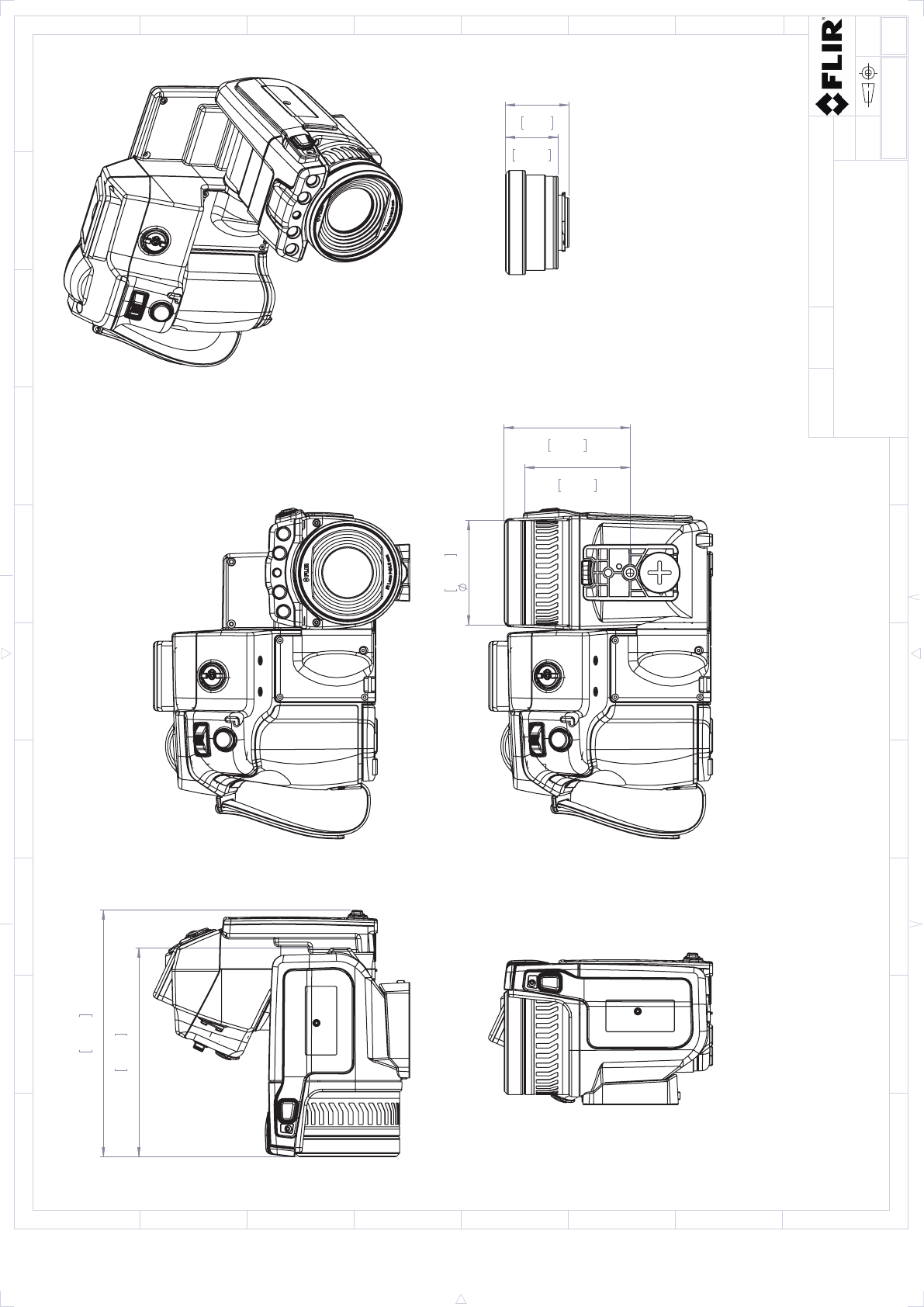
LQ
PP
LQ
PP
LQ
PP
LQ
PP
LQ
PP
LQ
PP
LQ
PP
)RUDGGLWLRQDOGLPHQVLRQVVHHSDJH
&DPHUDZLWK/HQV,5I PP
6KHHW
'UDZLQJ1R
6L]H
&KHFN
'UDZQE\
'HQRPLQDWLRQ
$
7
%DVLFGLPHQVLRQV)/,57[[PNOO
-27$
5'7KHUPRJUDSK\
0RGLILHG
$
%
&
'
(
)
*
+
&
)
%
'
*
(
$
6L]H
$
6FDOH
)/,56\VWHPV,QF$OOULJKWVUHVHUYHGZRUOGZLGH1RSDUWRIWKLVGUDZLQJPD\EHUHSURGXFHGVWRUHGLQDUHWULHYDOV\VWHPRUWUDQVPLWWHGLQDQ\IRUPRUE\DQ\PHDQVHOHFWURQLFPHFKDQLFDOSKRWRFRS\LQJUHFRUGLQJRURWKHUZLVH
ZLWKRXWZULWWHQSHUPLVVLRQIURP)/,56\VWHPV,QF6SHFLILFDWLRQVVXEMHFWWRFKDQJHZLWKRXWIXUWKHUQRWLFH'LPHQVLRQDOGDWDLVEDVHGRQQRPLQDOYDOXHV3URGXFWVPD\EHVXEMHFWWRUHJLRQDOPDUNHWFRQVLGHUDWLRQV/LFHQVHSURFHGXUHVPD\DSSO\
3URGXFWPD\EHVXEMHFWWR86([SRUW5HJXODWLRQV3OHDVHUHIHUWRH[SRUWTXHVWLRQV#IOLUFRPZLWKDQ\TXHVWLRQV'LYHUVLRQFRQWUDU\WR86ODZLVSURKLELWHG
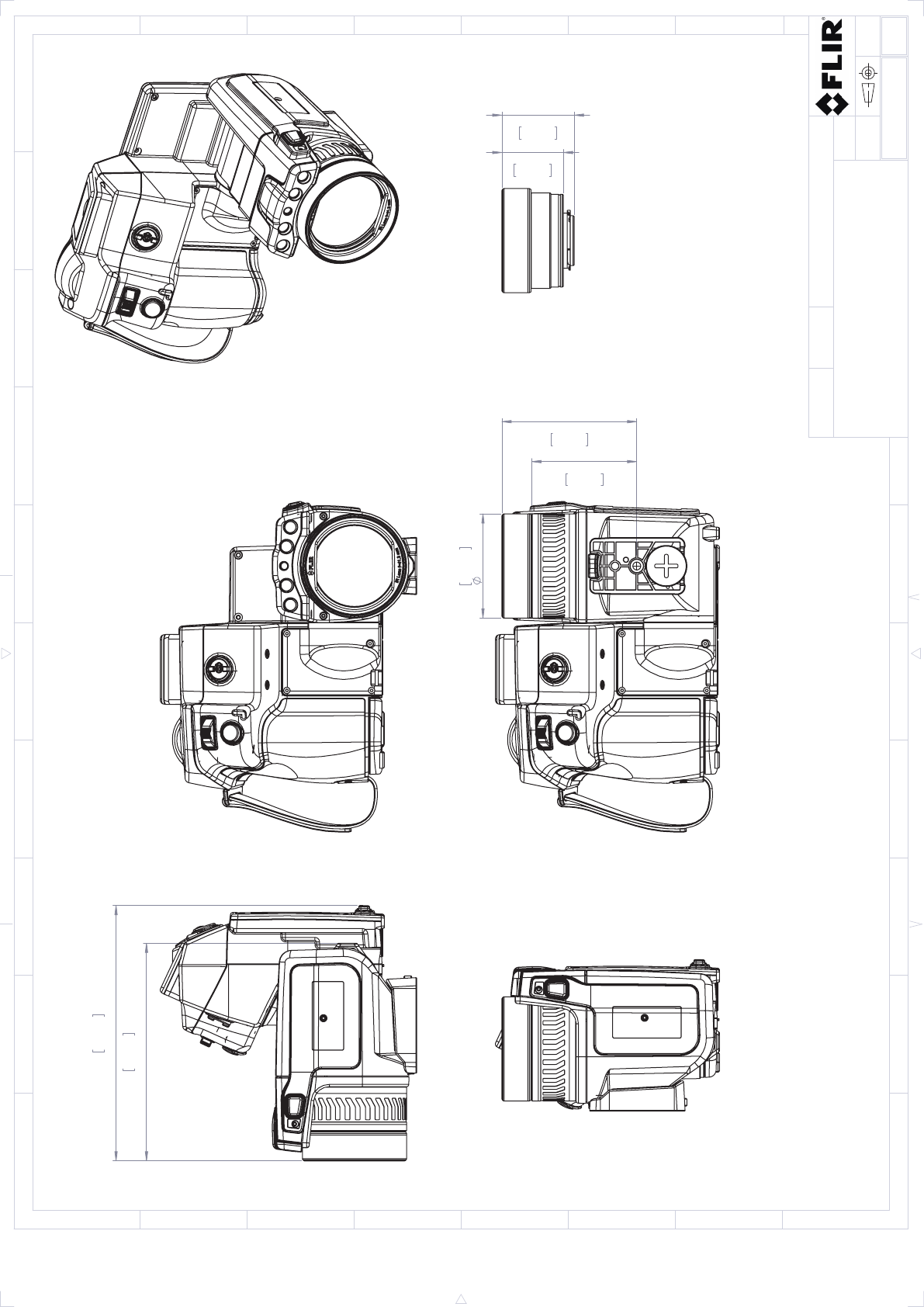
LQ
PP
LQ
PP
LQ
PP
LQ
PP
LQ
PP
LQ
PP
LQ
PP
)RUDGGLWLRQDOGLPHQVLRQVVHHSDJH
&DPHUDZLWK/HQV,5I PP
6KHHW
'UDZLQJ1R
6L]H
&KHFN
'UDZQE\
'HQRPLQDWLRQ
$
7
%DVLFGLPHQVLRQV)/,57[[PNOO
-27$
5'7KHUPRJUDSK\
0RGLILHG
$
%
&
'
(
)
*
+
&
)
%
'
*
(
$
6L]H
$
6FDOH
)/,56\VWHPV,QF$OOULJKWVUHVHUYHGZRUOGZLGH1RSDUWRIWKLVGUDZLQJPD\EHUHSURGXFHGVWRUHGLQDUHWULHYDOV\VWHPRUWUDQVPLWWHGLQDQ\IRUPRUE\DQ\PHDQVHOHFWURQLFPHFKDQLFDOSKRWRFRS\LQJUHFRUGLQJRURWKHUZLVH
ZLWKRXWZULWWHQSHUPLVVLRQIURP)/,56\VWHPV,QF6SHFLILFDWLRQVVXEMHFWWRFKDQJHZLWKRXWIXUWKHUQRWLFH'LPHQVLRQDOGDWDLVEDVHGRQQRPLQDOYDOXHV3URGXFWVPD\EHVXEMHFWWRUHJLRQDOPDUNHWFRQVLGHUDWLRQV/LFHQVHSURFHGXUHVPD\DSSO\
3URGXFWPD\EHVXEMHFWWR86([SRUW5HJXODWLRQV3OHDVHUHIHUWRH[SRUWTXHVWLRQV#IOLUFRPZLWKDQ\TXHVWLRQV'LYHUVLRQFRQWUDU\WR86ODZLVSURKLELWHG
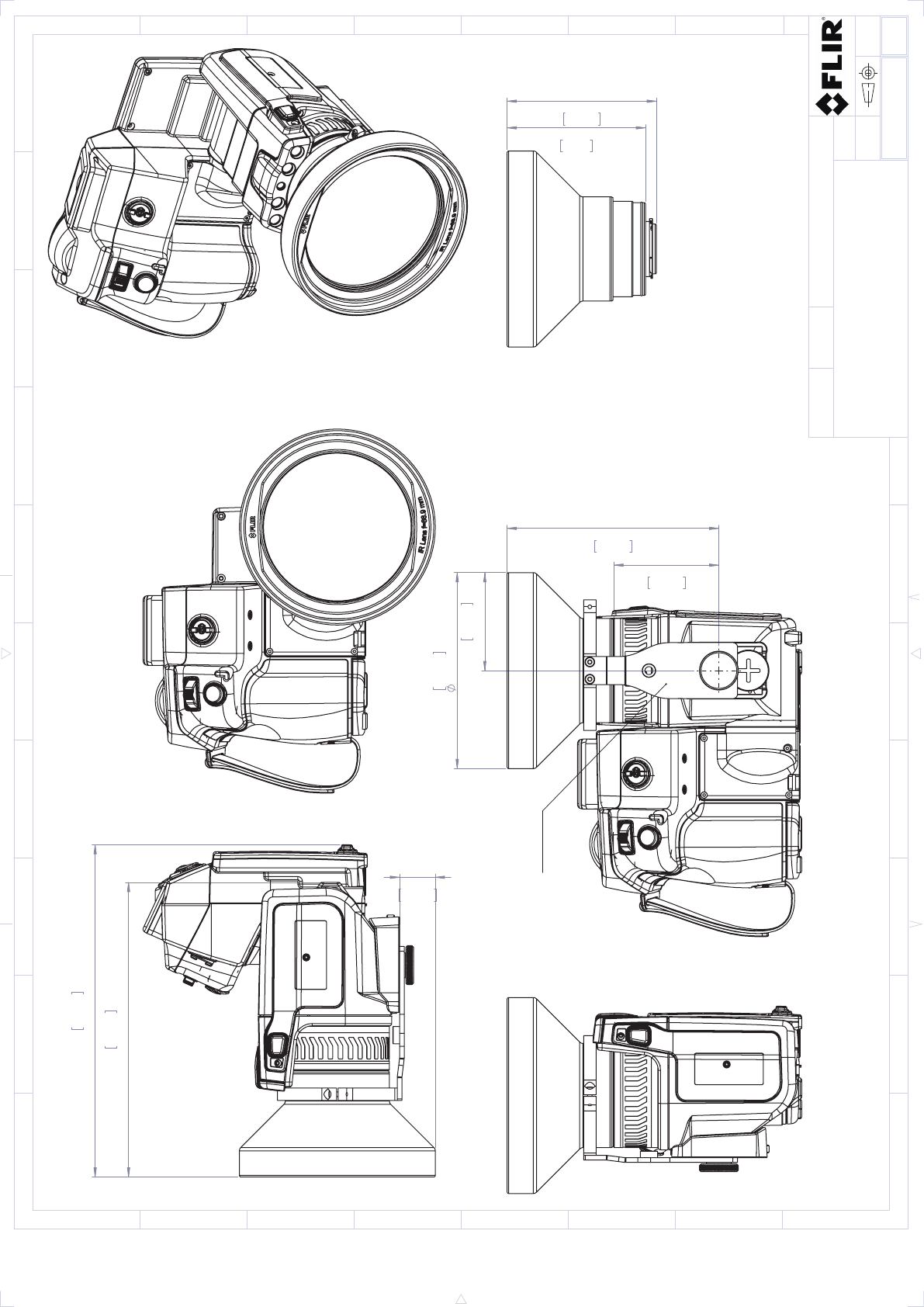
LQ
PP
LQ
PP
LQ
PP
LQ
PP
/HQVVXSSRUW
2SWLRQDO
LQ
PP
LQ
PP
LQ
PP
LQ
PP
LQ
PP
)RUDGGLWLRQDOGLPHQVLRQVVHHSDJH
&DPHUDZLWK/HQV,5I PPLQFOVXSSRUW
6KHHW
'UDZLQJ1R
6L]H
&KHFN
'UDZQE\
'HQRPLQDWLRQ
$
7
%DVLFGLPHQVLRQV)/,57[[PNOO
-27$
5'7KHUPRJUDSK\
0RGLILHG
$
%
&
'
(
)
*
+
&
)
%
'
*
(
$
6L]H
$
6FDOH
)/,56\VWHPV,QF$OOULJKWVUHVHUYHGZRUOGZLGH1RSDUWRIWKLVGUDZLQJPD\EHUHSURGXFHGVWRUHGLQDUHWULHYDOV\VWHPRUWUDQVPLWWHGLQDQ\IRUPRUE\DQ\PHDQVHOHFWURQLFPHFKDQLFDOSKRWRFRS\LQJUHFRUGLQJRURWKHUZLVH
ZLWKRXWZULWWHQSHUPLVVLRQIURP)/,56\VWHPV,QF6SHFLILFDWLRQVVXEMHFWWRFKDQJHZLWKRXWIXUWKHUQRWLFH'LPHQVLRQDOGDWDLVEDVHGRQQRPLQDOYDOXHV3URGXFWVPD\EHVXEMHFWWRUHJLRQDOPDUNHWFRQVLGHUDWLRQV/LFHQVHSURFHGXUHVPD\DSSO\
3URGXFWPD\EHVXEMHFWWR86([SRUW5HJXODWLRQV3OHDVHUHIHUWRH[SRUWTXHVWLRQV#IOLUFRPZLWKDQ\TXHVWLRQV'LYHUVLRQFRQWUDU\WR86ODZLVSURKLELWHG
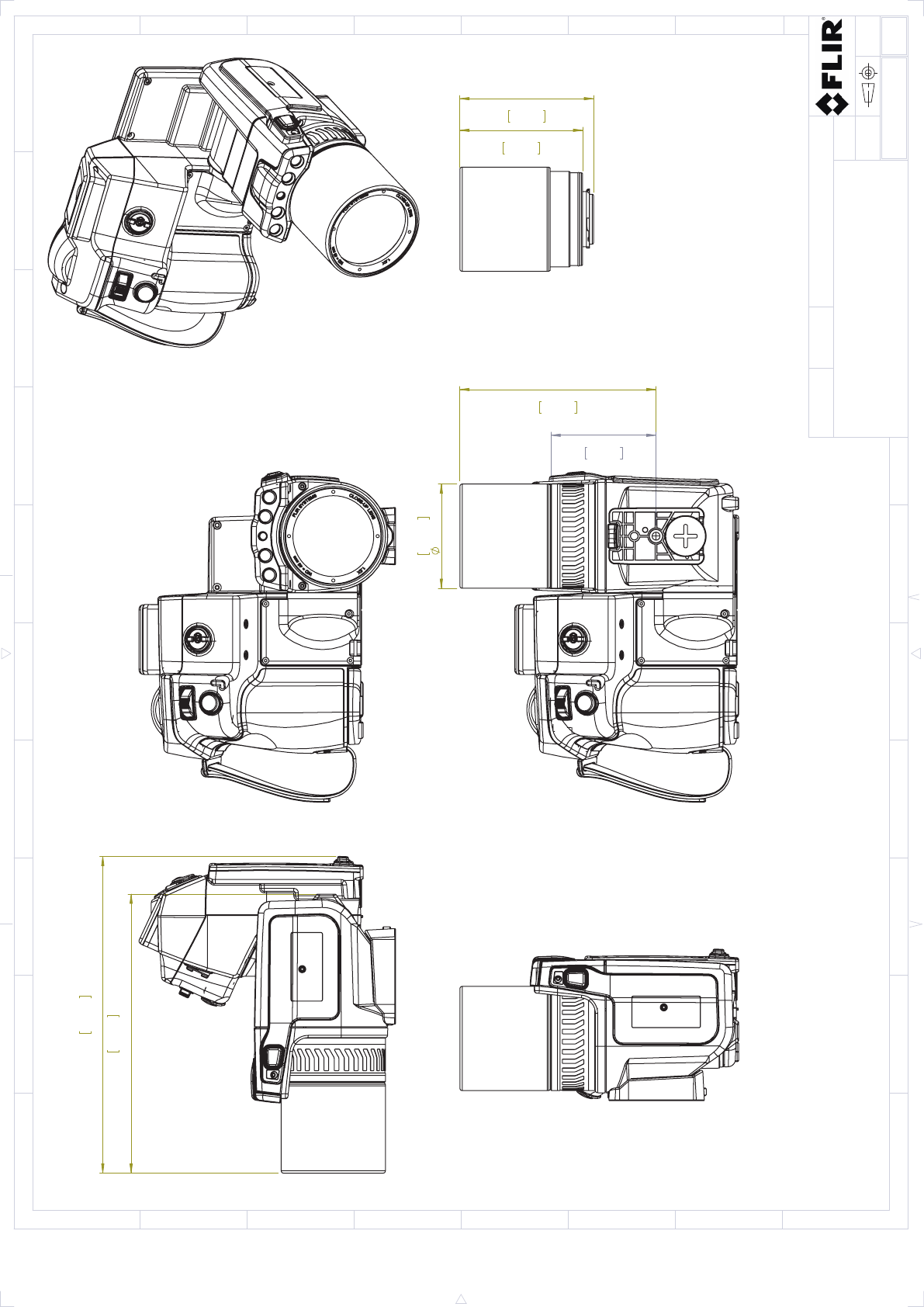
LQ
PP
LQ
PP
LQ
PP
LQ
PP
LQ
PP
LQ
PP
LQ
PP
)RUDGGLWLRQDOGLPHQVLRQVVHHSDJH
&DPHUDZLWK&ORVHXSOHQV;P
6KHHW
'UDZLQJ1R
6L]H
&KHFN
'UDZQE\
'HQRPLQDWLRQ
$
7
%DVLFGLPHQVLRQV)/,57[[PNOO
-27$
5'7KHUPRJUDSK\
0RGLILHG
$
%
&
'
(
)
*
+
&
)
%
'
*
(
$
6L]H
$
6FDOH
)/,56\VWHPV,QF$OOULJKWVUHVHUYHGZRUOGZLGH1RSDUWRIWKLVGUDZLQJPD\EHUHSURGXFHGVWRUHGLQDUHWULHYDOV\VWHPRUWUDQVPLWWHGLQDQ\IRUPRUE\DQ\PHDQVHOHFWURQLFPHFKDQLFDOSKRWRFRS\LQJUHFRUGLQJRURWKHUZLVH
ZLWKRXWZULWWHQSHUPLVVLRQIURP)/,56\VWHPV,QF6SHFLILFDWLRQVVXEMHFWWRFKDQJHZLWKRXWIXUWKHUQRWLFH'LPHQVLRQDOGDWDLVEDVHGRQQRPLQDOYDOXHV3URGXFWVPD\EHVXEMHFWWRUHJLRQDOPDUNHWFRQVLGHUDWLRQV/LFHQVHSURFHGXUHVPD\DSSO\
3URGXFWPD\EHVXEMHFWWR86([SRUW5HJXODWLRQV3OHDVHUHIHUWRH[SRUWTXHVWLRQV#IOLUFRPZLWKDQ\TXHVWLRQV'LYHUVLRQFRQWUDU\WR86ODZLVSURKLELWHG
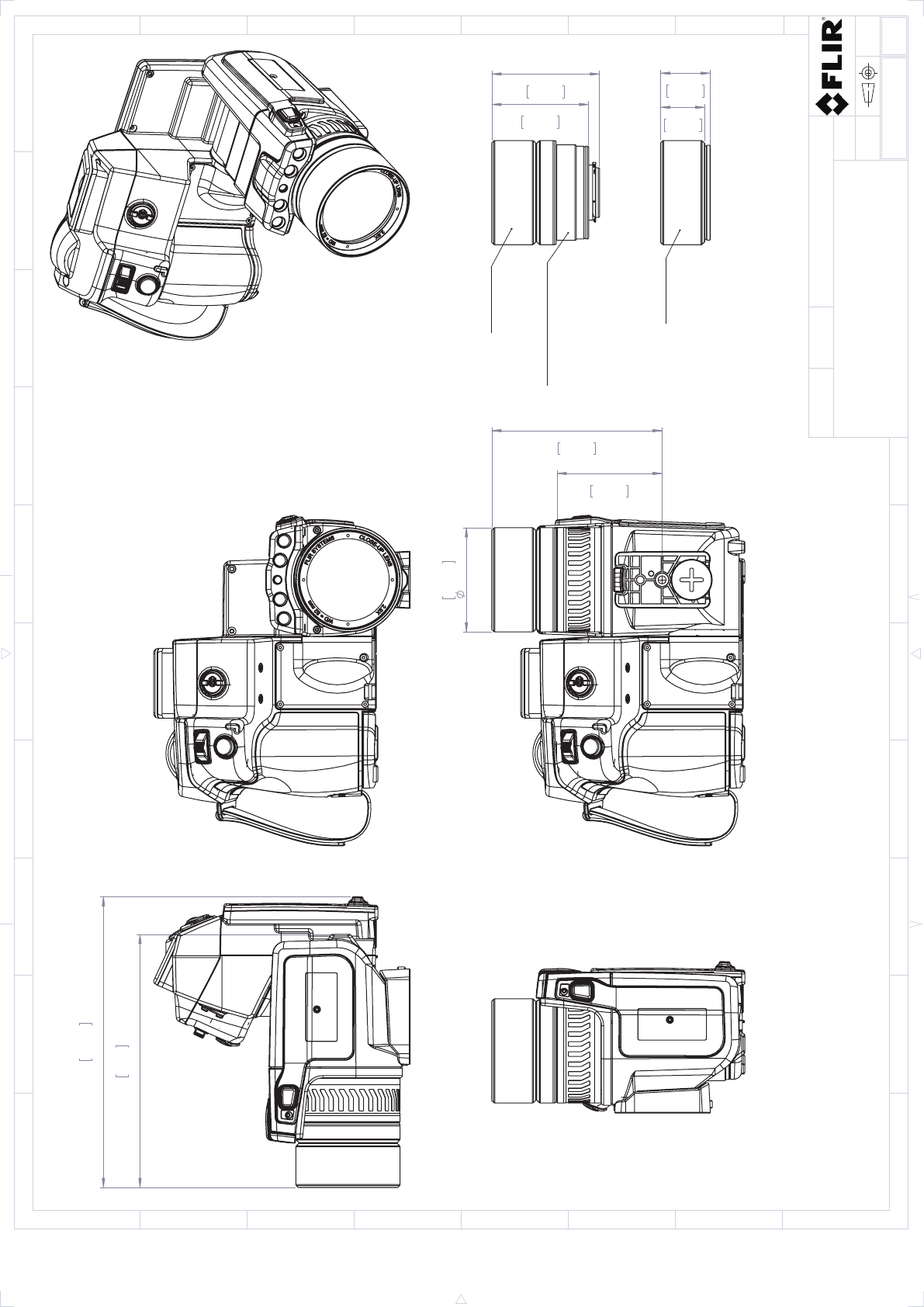
LQ
PP
LQ
PP
LQ
PP
LQ
PP
LQ
PP
LQ
PP
LQ
PP
,5/HQVI PP
&ORVHXSOHQV
LQ
PP
LQ
PP
&ORVHXSOHQV
)RUDGGLWLRQDOGLPHQVLRQVVHHSDJH
&DPHUDZLWK&ORVHXSOHQV;P
6KHHW
'UDZLQJ1R
6L]H
&KHFN
'UDZQE\
'HQRPLQDWLRQ
$
7
%DVLFGLPHQVLRQV)/,57[[PNOO
-27$
5'7KHUPRJUDSK\
0RGLILHG
$
%
&
'
(
)
*
+
&
)
%
'
*
(
$
6L]H
$
6FDOH
)/,56\VWHPV,QF$OOULJKWVUHVHUYHGZRUOGZLGH1RSDUWRIWKLVGUDZLQJPD\EHUHSURGXFHGVWRUHGLQDUHWULHYDOV\VWHPRUWUDQVPLWWHGLQDQ\IRUPRUE\DQ\PHDQVHOHFWURQLFPHFKDQLFDOSKRWRFRS\LQJUHFRUGLQJRURWKHUZLVH
ZLWKRXWZULWWHQSHUPLVVLRQIURP)/,56\VWHPV,QF6SHFLILFDWLRQVVXEMHFWWRFKDQJHZLWKRXWIXUWKHUQRWLFH'LPHQVLRQDOGDWDLVEDVHGRQQRPLQDOYDOXHV3URGXFWVPD\EHVXEMHFWWRUHJLRQDOPDUNHWFRQVLGHUDWLRQV/LFHQVHSURFHGXUHVPD\DSSO\
3URGXFWPD\EHVXEMHFWWR86([SRUW5HJXODWLRQV3OHDVHUHIHUWRH[SRUWTXHVWLRQV#IOLUFRPZLWKDQ\TXHVWLRQV'LYHUVLRQFRQWUDU\WR86ODZLVSURKLELWHG
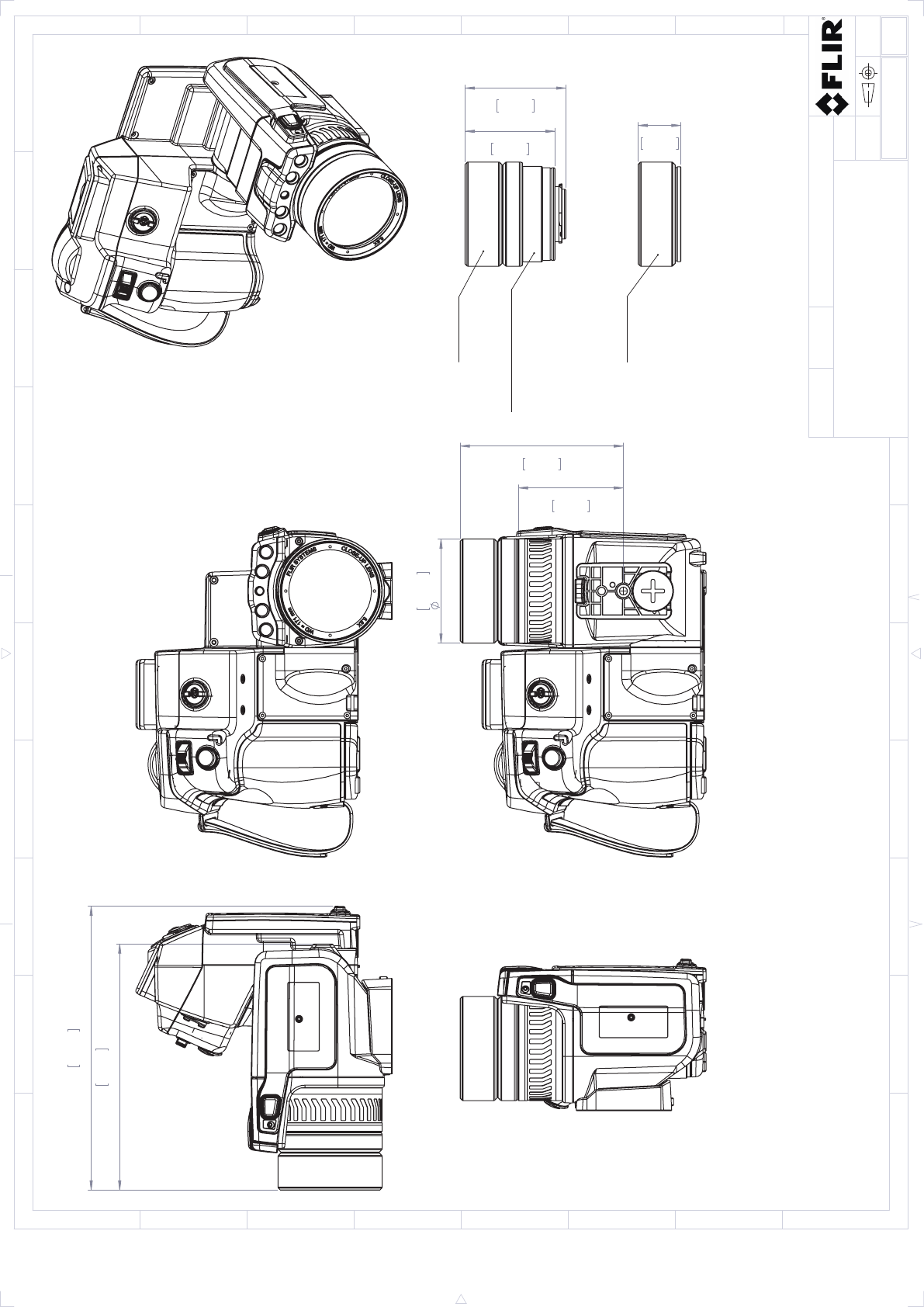
LQ
PP
LQ
PP
LQ
PP
LQ
PP
LQ
PP
LQ
PP
LQ
PP
,5/HQVI PP
&ORVHXSOHQV
LQ
PP
&ORVHXSOHQV
)RUDGGLWLRQDOGLPHQVLRQVVHHSDJH
&DPHUDZLWK&ORVHXSOHQV;P
6KHHW
'UDZLQJ1R
6L]H
&KHFN
'UDZQE\
'HQRPLQDWLRQ
$
7
%DVLFGLPHQVLRQV)/,57[[PNOO
-27$
5'7KHUPRJUDSK\
0RGLILHG
$
%
&
'
(
)
*
+
&
)
%
'
*
(
$
6L]H
$
6FDOH
)/,56\VWHPV,QF$OOULJKWVUHVHUYHGZRUOGZLGH1RSDUWRIWKLVGUDZLQJPD\EHUHSURGXFHGVWRUHGLQDUHWULHYDOV\VWHPRUWUDQVPLWWHGLQDQ\IRUPRUE\DQ\PHDQVHOHFWURQLFPHFKDQLFDOSKRWRFRS\LQJUHFRUGLQJRURWKHUZLVH
ZLWKRXWZULWWHQSHUPLVVLRQIURP)/,56\VWHPV,QF6SHFLILFDWLRQVVXEMHFWWRFKDQJHZLWKRXWIXUWKHUQRWLFH'LPHQVLRQDOGDWDLVEDVHGRQQRPLQDOYDOXHV3URGXFWVPD\EHVXEMHFWWRUHJLRQDOPDUNHWFRQVLGHUDWLRQV/LFHQVHSURFHGXUHVPD\DSSO\
3URGXFWPD\EHVXEMHFWWR86([SRUW5HJXODWLRQV3OHDVHUHIHUWRH[SRUWTXHVWLRQV#IOLUFRPZLWKDQ\TXHVWLRQV'LYHUVLRQFRQWUDU\WR86ODZLVSURKLELWHG
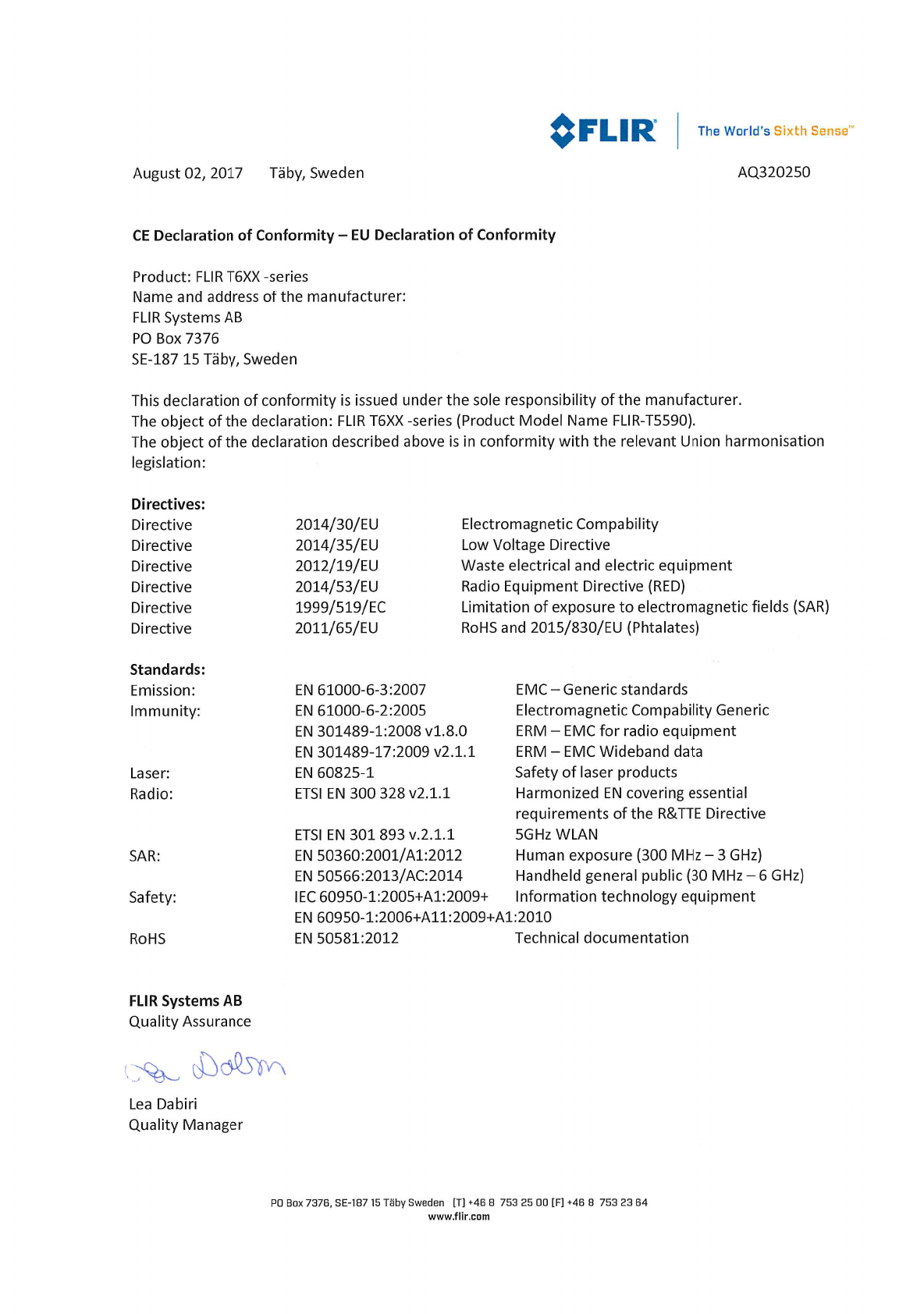
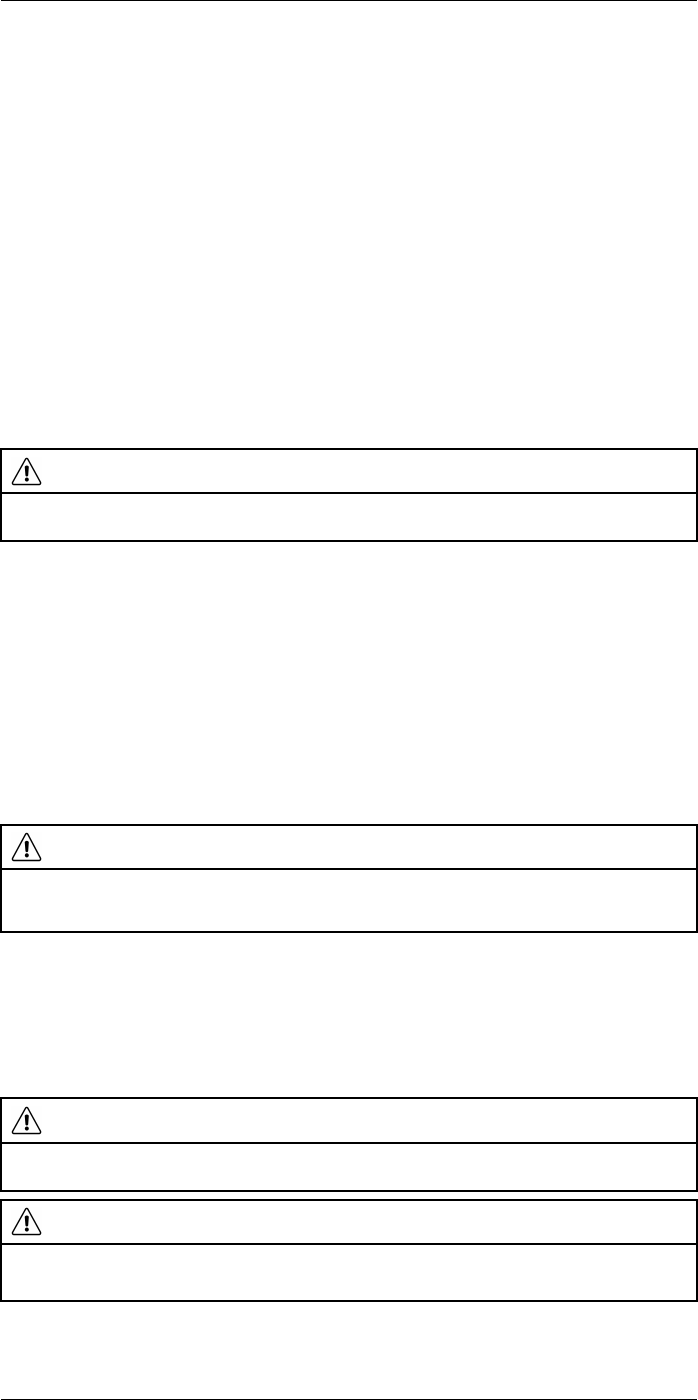
Cleaning the camera
27
27.1 Camera housing, cables, and other items
27.1.1 Liquids
Use one of these liquids:
• Warm water
• A weak detergent solution
27.1.2 Equipment
A soft cloth
27.1.3 Procedure
Follow this procedure:
1. Soak the cloth in the liquid.
2. Twist the cloth to remove excess liquid.
3. Clean the part with the cloth.
CAUTION
Do not apply solvents or similar liquids to the camera, the cables, or other items. This can cause
damage.
27.2 Infrared lens
27.2.1 Liquids
Use one of these liquids:
• A commercial lens cleaning liquid with more than 30% isopropyl alcohol.
• 96% ethyl alcohol (C2H5OH).
27.2.2 Equipment
Cotton wool
CAUTION
If you use a lens cleaning cloth it must be dry. Do not use a lens cleaning cloth with the liquids that are
given in section 27.2.1 above. These liquids can cause material on the lens cleaning cloth to become
loose. This material can have an unwanted effect on the surface of the lens.
27.2.3 Procedure
Follow this procedure:
1. Soak the cotton wool in the liquid.
2. Twist the cotton wool to remove excess liquid.
3. Clean the lens one time only and discard the cotton wool.
WARNING
Make sure that you read all applicable MSDS (Material Safety Data Sheets) and warning labels on con-
tainers before you use a liquid: the liquids can be dangerous.
CAUTION
• Be careful when you clean the infrared lens. The lens has a delicate anti-reflective coating.
• Do not clean the infrared lens too vigorously. This can damage the anti-reflective coating.
#T559880; r. AL/45866/46124; en-US 456

Cleaning the camera
27
27.3 Infrared detector
27.3.1 General
Even small amounts of dust on the infrared detector can result in major blemishes in the
image. To remove any dust from the detector, follow the procedure below.
Note
• This section only applies to cameras where removing the lens exposes the infrared
detector.
• In some cases the dust cannot be removed by following this procedure: the infrared
detector must be cleaned mechanically. This mechanical cleaning must be carried out
by an authorized service partner.
CAUTION
In Step 2 below, do not use pressurized air from pneumatic air circuits in a workshop, etc., as this air
usually contains oil mist to lubricate pneumatic tools.
27.3.2 Procedure
Follow this procedure:
1. Remove the lens from the camera.
2. Use pressurized air from a compressed air canister to blow off the dust.
#T559880; r. AL/45866/46124; en-US 457
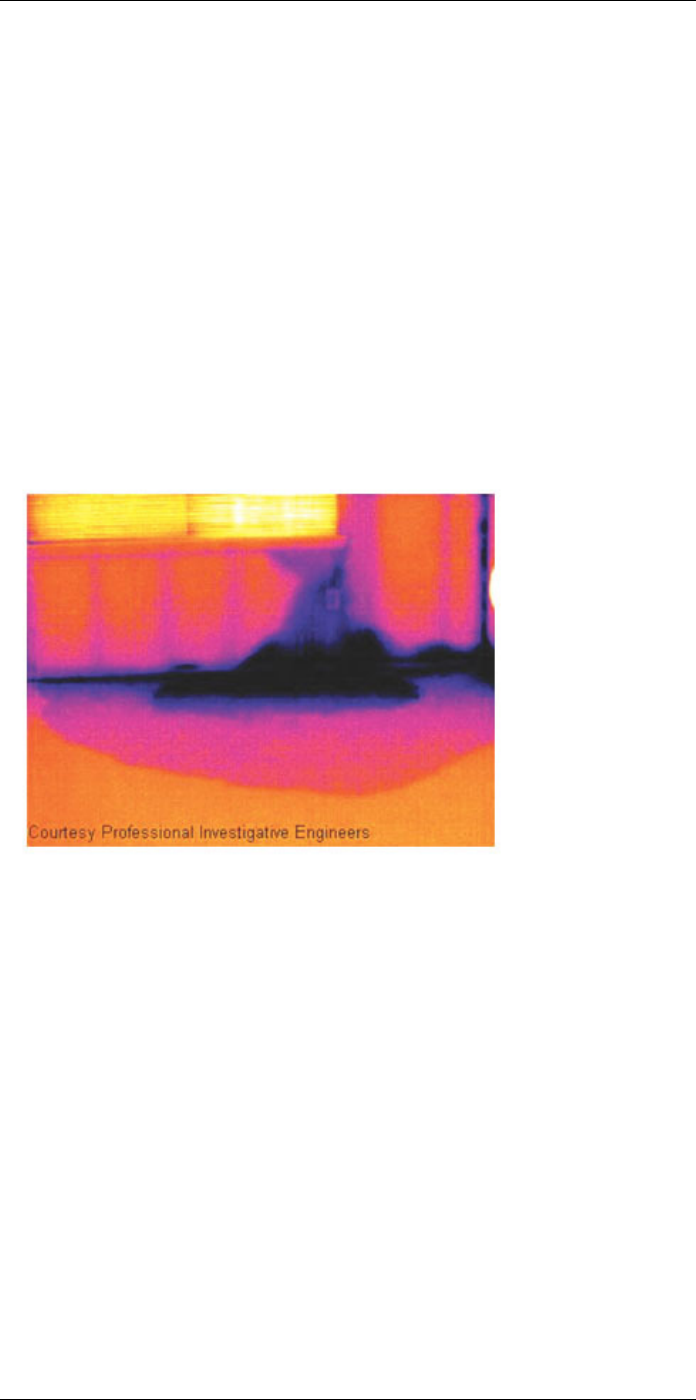
Application examples
28
28.1 Moisture & water damage
28.1.1 General
It is often possible to detect moisture and water damage in a house by using an infrared
camera. This is partly because the damaged area has a different heat conduction prop-
erty and partly because it has a different thermal capacity to store heat than the sur-
rounding material.
Many factors can come into play as to how moisture or water damage will appear in an
infrared image.
For example, heating and cooling of these parts takes place at different rates depending
on the material and the time of day. For this reason, it is important that other methods are
used as well to check for moisture or water damage.
28.1.2 Figure
The image below shows extensive water damage on an external wall where the water
has penetrated the outer facing because of an incorrectly installed window ledge.
28.2 Faulty contact in socket
28.2.1 General
Depending on the type of connection a socket has, an improperly connected wire can re-
sult in local temperature increase. This temperature increase is caused by the reduced
contact area between the connection point of the incoming wire and the socket , and can
result in an electrical fire.
A socket’s construction may differ dramatically from one manufacturer to another. For
this reason, different faults in a socket can lead to the same typical appearance in an in-
frared image.
Local temperature increase can also result from improper contact between wire and
socket, or from difference in load.
28.2.2 Figure
The image below shows a connection of a cable to a socket where improper contact in
the connection has resulted in local temperature increase.
#T559880; r. AL/45866/46124; en-US 458

